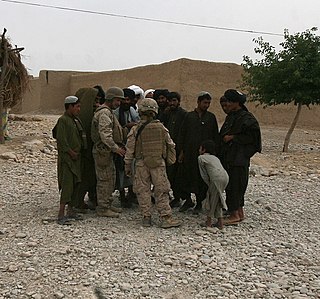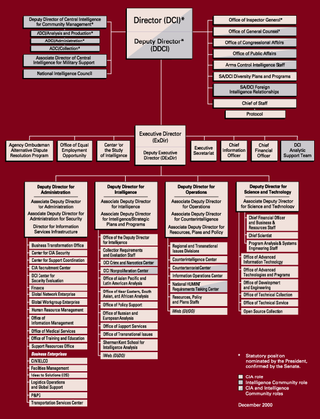Communications in Burundi include radio, television, fixed and mobile telephones, the Internet, and the postal service in Burundi.
Telecommunications in Equatorial Guinea include radio, television, fixed and mobile telephones, and the Internet.
Telecommunications in Sudan includes fixed and mobile telephones, the Internet, radio, and television. Approximately 12 million out of 45 million people in Sudan use the Internet, mainly on smartphones and mobile computers.

Military intelligence is a military discipline that uses information collection and analysis approaches to provide guidance and direction to assist commanders in their decisions. This aim is achieved by providing an assessment of data from a range of sources, directed towards the commanders' mission requirements or responding to questions as part of operational or campaign planning. To provide an analysis, the commander's information requirements are first identified, which are then incorporated into intelligence collection, analysis, and dissemination.

Radio Free Europe/Radio Liberty (RFE/RL) is a United States government funded organization that broadcasts and reports news, information, and analysis to countries in Eastern Europe, Central Asia, Caucasus, and the Middle East where it says that "the free flow of information is either banned by government authorities or not fully developed". RFE/RL is a private, non-profit 501(c)(3) corporation supervised by the U.S. Agency for Global Media, an independent government agency overseeing all U.S. federal government international broadcasting services. Jeremy Bransten is acting editor-in-chief of RFE.

Counterintelligence is an activity aimed at protecting an agency's intelligence program from an opposition's intelligence service. It includes gathering information and conducting activities to prevent espionage, sabotage, assassinations or other intelligence activities conducted by, for, or on behalf of foreign powers, organizations or persons.
Open-source intelligence (OSINT) is the collection and analysis of data gathered from open sources to produce actionable intelligence. OSINT is primarily used in national security, law enforcement, and business intelligence functions and is of value to analysts who use non-sensitive intelligence in answering classified, unclassified, or proprietary intelligence requirements across the previous intelligence disciplines.

The United States Intelligence Community (IC) is a group of separate United States government intelligence agencies and subordinate organizations that work both separately and collectively to conduct intelligence activities which support the foreign policy and national security interests of the United States. Member organizations of the IC include intelligence agencies, military intelligence, and civilian intelligence and analysis offices within federal executive departments.
An intelligence officer is a person employed by an organization to collect, compile or analyze information which is of use to that organization. The word of officer is a working title, not a rank, used in the same way a "police officer" can also be a sergeant, or in the military, in which non-commissioned personnel may serve as intelligence officers.

The CIA Library is a library available only to Central Intelligence Agency personnel, contains approximately 125,000 books and archives of about 1,700 periodicals. Many of its information resources are available via its Digital Library, which include CD-ROMs and web-based resources.
The Intelligence cycle describes how intelligence is ideally processed in civilian and military intelligence agencies, and law enforcement organizations. It is a closed path consisting of repeating nodes, which will result in finished intelligence. The stages of the intelligence cycle include the issuance of requirements by decision makers, collection, processing, analysis, and publication of intelligence. The circuit is completed when decision makers provide feedback and revised requirements. The intelligence cycle is also called the Intelligence Process by the U.S. Department of Defense (DoD) and the uniformed services.
The Open Source Enterprise (OSE) is a United States Government organization dedicated to open-source intelligence that was established by Assistant Deputy Director of National Intelligence for Open Source (ADDNI/OS), Eliot A. Jardines. They provide material to the National Technical Information Service (NTIS) and other government officials through the online news service World News Connection.
Readex, a division of NewsBank, publishes collections of primary source research materials.
Intelligence cycle management refers to the overall activity of guiding the intelligence cycle, which is a set of processes used to provide decision-useful information (intelligence) to leaders. The cycle consists of several processes, including planning and direction, collection, processing and exploitation, analysis and production, and dissemination and integration. The related field of counterintelligence is tasked with impeding the intelligence efforts of others. Intelligence organizations are not infallible but, when properly managed and tasked, can be among the most valuable tools of management and government.

The Central Intelligence Agency (CIA) is a civilian foreign intelligence service of the United States federal government, tasked with gathering, processing, and analyzing national security information from around the world.
World News Connection was a compilation of current international news translated into the English language. The United States Department of Commerce National Technical Information Service compiled and distributed it from non-U.S. media sources, usually within 24–72 hours from the time of the original publication or broadcast.
The Joint Publications Research Service (JPRS) was a United States government defense-funded organization that was absorbed into the Foreign Broadcast Information Service (FBIS) but its funding and personnel did not transfer. For all practical purposes it ceased its massive operations in 1970, and gradually wound down to virtually nothing under FBIS by 1997.

The CIA publishes organizational charts of its agency. Here are a few examples.

In 1995 it was revealed that the Central Intelligence Agency had delivered intelligence reports to the U.S. government between 1986 and 1994 which were based on agent reporting from confirmed or suspected Soviet operatives. From 1985 to his arrest in February 1994, CIA officer and KGB mole Aldrich Ames compromised Agency sources and operations in the Soviet Union and Eastern Europe, leading to the arrest of many CIA agents and the execution of at least ten of them. This allowed the KGB to replace the CIA agents with its own operatives or to force them to cooperate, and the double agents then funneled a mixture of disinformation and true material to U.S. intelligence. Although the CIA's Soviet-East European (SE) and Central Eurasian divisions knew or suspected the sources to be Soviet double agents, they nevertheless disseminated this "feed" material within the government. Some of these intelligence reports even reached Presidents Ronald Reagan and George H. W. Bush, as well as President-elect Bill Clinton.

The National Open Source-Intelligence Agency (NOSA) is a proposed 19th member of the United States Intelligence Community (IC) to be tasked with the collection and exploitation of open-source intelligence (OSINT). Creation of the agency would consolidate open source efforts across the US government into a new functional manager for the open-source intelligence discipline, drawing resources from the Open Source Enterprise of the Central Intelligence Agency, the Open Source Integration Center (OSIC) of the Defense Intelligence Agency, the National Geospatial-Intelligence Agency, as well as other open source focused entities across the government.











